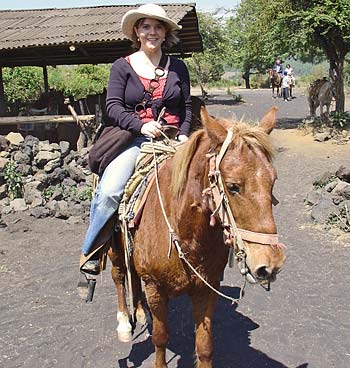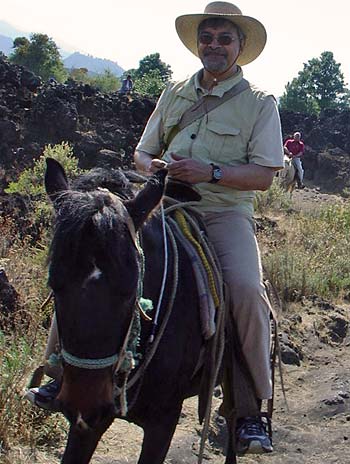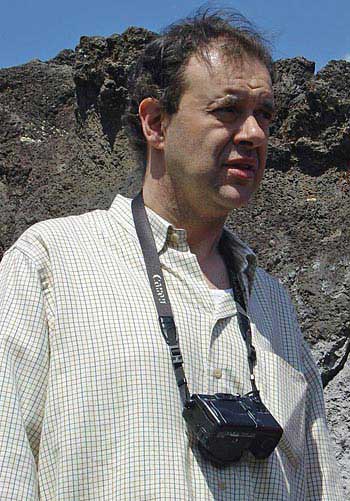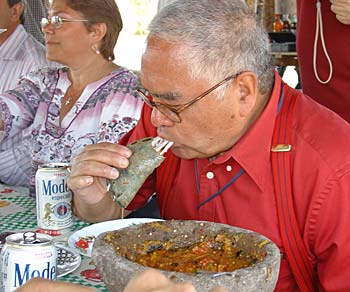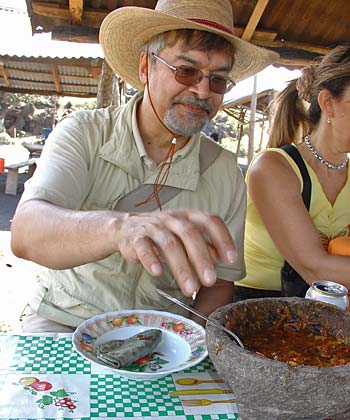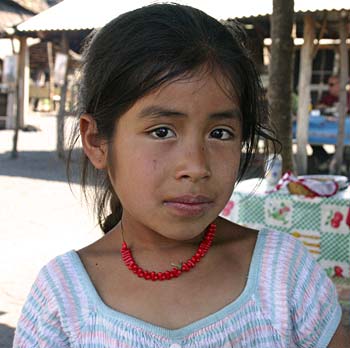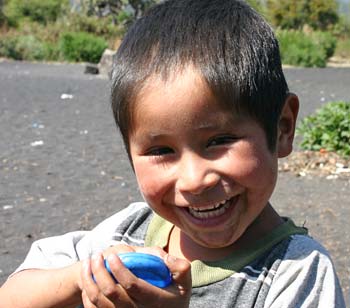
Before we embark on our narrative I would like to draw the attention of
our readers to some updates we have made to our round reports from the chess
tournament itself. First of all the report
on round seven has been updated and the fine analysis provided by GM Mihail
Marin is now replayable on a JavaScript board.
Secondly, as a number of readers have remarked, the round
six report was uncharacteristically cursory in its analysis of games. Had
GM Marin somehow lost interest, did he believe the games of this round were
unworthy of his attention? No, dear readers, it was a transmission error. We
subsequently received an uncorrupted file with the full analysis – which
was in fact more detailed than any of the previous rounds. We have updated
the report to include everthing our Rumanian colleague has sent us.
Now to the report, which Vishy Anand has disrespectfully referred to as
"one of your travel blogs".
Morelia – A Treck to the Volcano
By Federico Friedelez
On the second free day of the Ciudad de Linares-Morelia tournament
our hosts had organised an outing for participants, journalists and special
guests. It was by minibus and for some reason we were under the impression that
it was a quick, three-hour trip to a nature reserve. But it turned out to be
something considerably more dramatic.
El volcán Paricutin, the Paricutin volcano, has a unique place
geological in history and research, for the simple reason that human beings were
there to witness its birth. In 1943 the volcano literally emerged from corn
fields around the village of Paricutin, just a few hours drive from Morelia,
in the district of Michoacán. It quickly destroyed the village and the
nearby town of San Juan Parangaricutiro, spewing columns of ash many kilometers
into the air during its explosive pyroclastic phase.
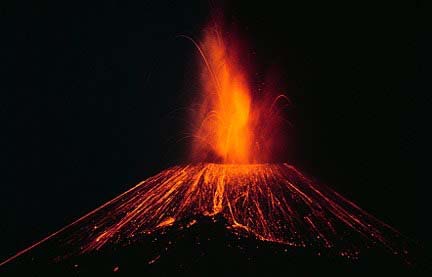
A historical photograph of the Paricutin volcano erupting,
made by K. Segerstrom for the U.S. Geological Survey in 1946.
Within a year the new volcano had grown to 350 meters and continued to erupt,
more quietly, until 1952. By then it had achieved a hight of 425 meters. This
is above the surrounding countryside, which is 3200 meters above sea level.

The road to Paricutin. We travelled in two mini-busses provided by the organisers.
The trip to the volcano is almost three hours long, over dusty and often crowded
Mexican highways.
At one of our "pit-stops" in a road-side village we meet Michael,
a missionary from the Michigan. He briefs us on the national park we are about
to visit, telling us that it is as close to heaven as you can get here on earth.
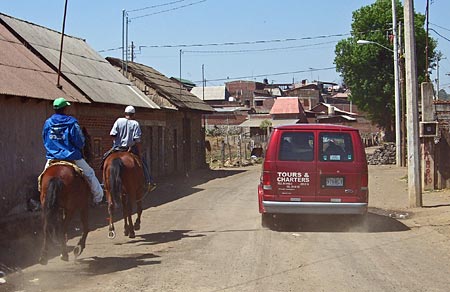
As we approach our destination horse riders join our little convoy. We are
still completely innocent of what is in store for us.

The scenery as we approach the Paricutin volcano, which is part of the Michoacán-Guanajuato
field, consisting of a series of older cinder cones and lava flows.
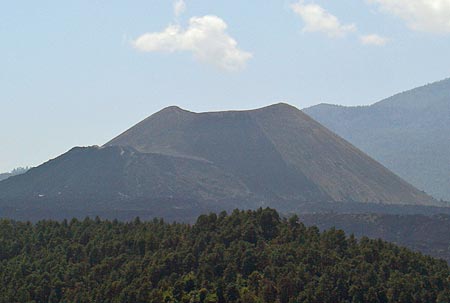
Paricutin looms ominously ahead of us. It has been quiet since the last eruption
in 1952, and we are told that as a "monogenetic volcano" it will never
erupt again. Quite a relief, although a cataclysmic eruption would have probably
resulted in more interesting visuals for this report.

The sun is quite brutal at the volcano base station. Fortunately a new-found
friend, Arturo Xicoténcatl (right), gives me (left) a Mexican hat, which
he purchases from a local vendor. It will feature prominently in the pictures
below. Mexican hats are made of straw, light and airy. I believe I may not have
survived the ascent without one. Naturally I am taking it back to Germany with
me, as one of my most prized souvenirs.

We are provided with the best form of transportation for the arduous treck
to the volcano: horses. Some of us have never been on horseback before, but
our guides assure us that the animals are "caballos especiales", very
well-behaved animals that are patient with newbies.
My colleague Nadja, like most German females, had riding lessons as a girl.
She also has an especially friendly horse named Pansón, who fortunately
is great friends with my own mount named Totacurri.
The Mexicanisation of the ChessBase news editor formerly known as Frederic
Friedel.
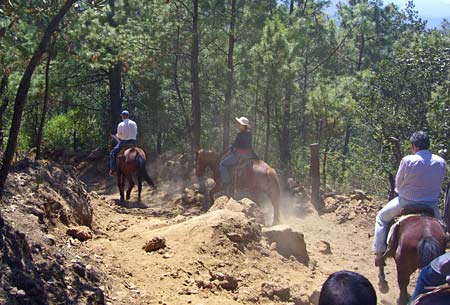
We set off on a dusty trail towards the volcano. The dirt path through the forest
soon give way to volcanic debris and lava fields.

Soon the trail becomes quite treacherous, and we are thankful that the horses
step carefully. They have obviously negotiated the passage many times and seem
to know what they are doing.
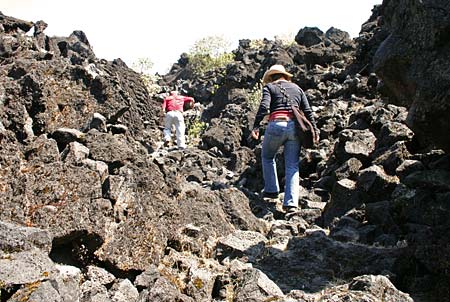
In the end we have to dismount at the base camp and proceed on foot. It is
quite awe-inspiring to climb through these recent lava flows. In some places
the path has been blasted free.
The church of Paricutin, which was left standing by the lava, which flowed
around it. This is considered a miracle by the local population...
...as this wizened original inhabitant of Paricutin village tells us. He actually
witnessed the eruption as a child and tells us that by God's grace nobody was
killed by it.

This is where the old man used to kneel, where he received his first holy communion,
just before the volcano tore through the nave of the church.
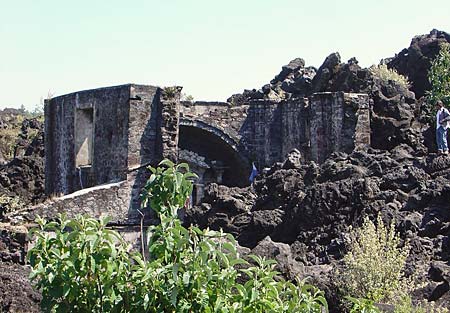
It is clear that the lava went right through the church. Only the far wall,
shown in this picture, and one of the main spires remain standing.

You get a feel for the dimensions of the lava flows when you see the human
ants crawling across them.
Jesús Boyero, the journalist who covers chess for the sports newspaper
MARCA. It is more widely read than any of the broadsheets.
Some people cannot resist the urge to gratuitously scale the highest point
in the landscape. Probably the cross is for a previous climber who had taken
a false step on the sometimes loose boulders of the slopes. The cameraman from
Linares TV is adjusting his focus in order to catch the moment, if it should
come.

Back in the base camp we go to a little Mexican restaurant for a bite to eat,
and more urgently for an ice-cold Mexican beer.

A mother-daughter duo prepare tortillas for us. The daughter is the one in
a green skirt in the background.
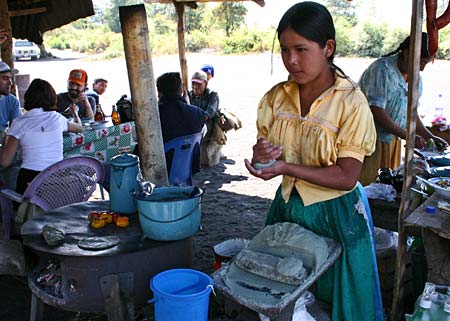
The tortillas are made by curing maize in lime water (to rid it of certain
hard-to-digest substances) and then grinding it to a firm dough on a flat stone.
The individual tortillas are made by pat-pat-patting a lump of dough between
the hands, which makes it sound as if there is a lot of clapping going on all
around the camp.

The tortillas are roasted on a very hot metal griddle called a comal,
heated by wood from below. Some of the tortillas are just plain, some are filled
with cheese and greens and folded into halves. On the top left a few tomatoes
and some chiles manzana ("apple chillies") are being blackened.

The tomatos and chiles manzana are smashed up in a molcajete (mortar
and pestle), which in this region is made of volcanic stone. I believe the entire
recipe used for the salsa they served us was to crush equal amounts of tomatoes
and chiles, add some salt, pepper, oil and the ubiquitous green lemon juice.
The salsa is served in molcajete in which it was made. It was the
most delicious I have ever tried – don't ask, just put it on everything
you eat. I have packed a bunch of fresh chiles manzana to take back with me,
to try and duplicate this truly remarkable salsa in Germany.
Our friend Arturo, who invited us to this finest of all meals, eating a cheese
tortilla with the magical salsa. Arturo is a journalist who has been covering
chess and other things for major wire services for almost sixty years now. His
trademark is well-chosen colour-matched suspenders.
A full-blooded Mexican going for the salsa, and wondering why people bother
to eat anything else. Incidentally very hot food is addictive because it comes
with a side order of endorphins. The brain reacts to hot food by releasing the
body's natural painkillers, natural opiates that can change a painful experience
into a pleasurable one.
The younger daughter of our hosts. Soon she will be making the best tortillas
in the world.
The youngest member of this charming Mexican family. One day he will be taking
guests on horseback up the Paricutin volcano – or the new one that springs
out of the ground in this geologically active region.
Photos by Frederic Friedel and Nadja Woisin
Links



























